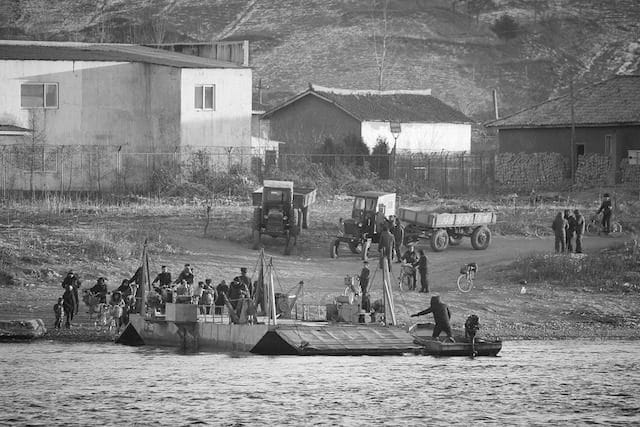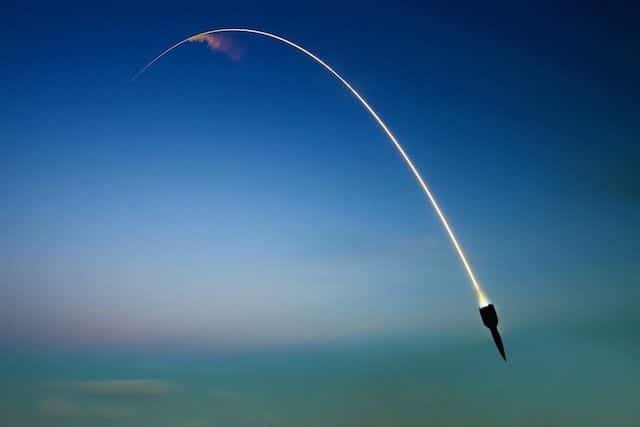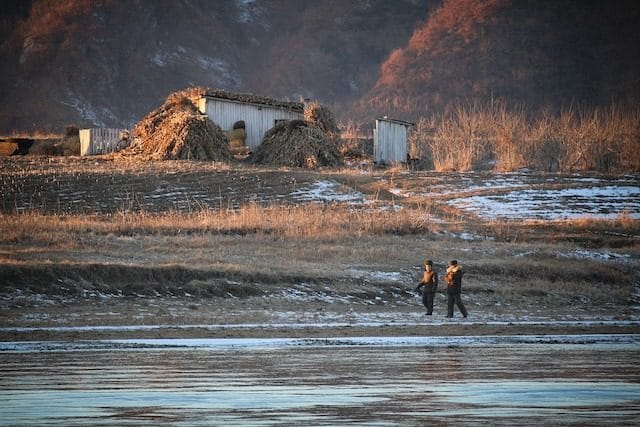Kim Jong-un’s North Korea continues to be a cruel oddity, as countries go. Although some progress has been made towards turning the People’s Republic into something its people can actually live in, by all accounts it’s still a pretty ruthless place for the average citizen. Here’s a look at some brutal realities of life in the most secretive country in the world.
10. Labor camps

Every self-respecting ruthless dictator has a labor camp or a hundred in his back pocket, but North Korea’s version of the theme is particularly brutal. Kang Cheol-hwan is a former labor camp prisoner who spent 10 grueling years at the Yodok concentration camp, which was a hidden in a mountainous region and hosted “enemies of the state.” Kang himself had done nothing wrong: He ended up in the camp as a child, with his high-ranking parents who had criticized the Kims for going against communist ideals and turning the North Korean leadership into a dynasty. There, the young Kang was confined to a life of back-breaking labor, which included tasks like hauling heavy wood for several miles.
Still, no matter how brutal the work was, disobeying was not an option. Those who refused to obey orders were taken to a special prison within the camp, where they were confined to tiny cells with cold, muddy water covering the floor. Most didn’t survive this, and the ones who did were damaged beyond repair: The water had literally rotted their flesh. Somehow, this wasn’t even the most humiliating way to die at the camp: Sometimes, the guards hanged prisoners, and the other prisoners were forced to watch and throw stones at the hanged man. The guards would keep the corpse up for a week, and the elements, carrion birds and the effect of the stoning would render it unrecognizable.
Ultimately, Kang was one of the lucky ones: He and his parents were eventually released from the camp. Unsurprisingly, Kang escaped the country the first chance he got, and became a director of the NGO North Korea Strategy Centre, a defector-led human rights organization.
9. Famines

It probably comes as no surprise that a country led as … erratically as North Korea has the occasional problem with food production. What you might not know is just how bad their situation is. The country is the territorial equivalent of a guy who’s just one bounced paycheck away from not making rent: Almost every single mishap runs the risk of sending them plunging into a food shortage. The problem is that they tend to attract plenty of mishaps: As recently as in 2017, they were teetering on the edge of a massive famine caused by a combination of international sanctions, massive drought, and the government’s stubborn tendency to pour way too much of the country’s extremely limited resources into various military programs.
Perhaps the most legendary famine in North Korea’s history was the Arduous March of the mid-1990s. The seeds of the Arduous March were sowed way back in 1948, when the country was created and it became apparent that its soil was less than ideal for food production. Kim Il Sung was able to sidestep the issue by allying himself closely with the Soviet Union, who were happy to throw some food and fuel his way to support the cause. However, when the Soviet Union began to falter, the aid stopped coming and North Korea was left to its own devices. Kim had already started pushing an isolationist policy, so he decreed that North Koreans should be able to feed themselves.
This worked roughly as well as expected, which is to say not at all. Without a steady Soviet supply of fuel and food, the country lost its backup food supplies and the ability to produce chemical fertilizers for their own farms. When El Niño flooded a good chunk of North Korea’s already scant farmland in 1995 and 1996, all ingredient for a recipe for disaster were in place. The entire country hit panic mode: Farmers hid parts of their crops for themselves, international food relief was stolen and hoarded by elite officials as soon as the shipments arrived. Soon, the government stopped distributing food altogether, and hundreds of thousands of desperate North Koreans were flooding out of the country, regardless of the travel ban and its repercussions.
No one knows the true death toll of the famine, because the North Korean leaders appear to pretend that it never happened. However, estimates indicate that it may have killed millions of people.
8. The “three generations rule”

The “three generations rule” is possibly the most ruthless policy in the already pretty awful North Korean prison system. Its basic gist is this: If a citizen commits a crime, they’re sent to a labor camp, and the sentence also applies to a full three generations of their family. This means that children can be born in the prison camp and they’re already sentenced because of something their parents or grandparents may or may not have done.
This punishment is mostly directed at people who are disloyal to the government, and it can be seriously hazardous to the mentality of the people who are forced to suffer for a crime that was committed decades before they were even born. One defector describes that he could not conceive what the world was like, and could not even have thought of escaping because the prison camp was all he knew … and he thought that the whole world outside the camp’s borders was just more of the same.
7. Forced mass choreographies
North Korea has a strange tradition. Well, it has a lot of strange traditions, but one of the most famous ones is the Mass Games — a strange event that consists of parades, gymnastic performances and impressive mass choreographies performed by scores of people. According to North Korea researcher Andray Abrahamian, the games are “the official national narrative bundled into a 90-minute spectacle,” and as such, they’re highly valued by the leadership.
But how does a broke, isolationist country like North Korea have so many experts on choreography at its disposal? By force, of course. In the past, up to 100,000 people have been mobilized to take part in the event. For the 2018 Mass Games, thousands and thousands of schoolchildren practiced from early morning to late at night, causing human rights groups to criticize the event as straight up child labor. There are reports of children training for months in all weathers, and being fed urinary infection medication to cope with the long hours of sitting in the cold. Still, it’s said that the households that participate in the Games often receive certain benefits such as color televisions (yes, they’re still a rarity in North Korea), so people actually compete to participate in the event.
6. Media restrictions

A large part of North Korea’s mysterious reputation is due to the fact that they don’t really treat freedom of press as a thing that exists. For a North Korean citizen, it’s borderline impossible to get any real information on what’s going on in the country. Every single domestic media outlet is controlled by the state, and government supervision and censorship run rampant.
Foreign medias that have established offices in the hermit nation are only marginally better off. Their access is tightly restricted, and news teams have been known to be thrown out of the country whenever their work doesn’t please the powers that be. In fact, leaving the country might be the best case scenario for a journalist who has fallen out of favor with Pyongyang: In August 2017, two South Korean journalists and their publishers were sentenced to death, just because they had dared to review a book that happened to discuss socio-economic changes the country has gone through in recent years. Fortunately, the journalists were nowhere near North Korea at the time.
5. Executions

Since North Korea doesn’t think twice of throwing its citizens in a concentration camp until they (sometimes literally) rot away, it probably comes as no surprise that they occasionally execute people. We already mentioned the brutal hanging/stoning deaths and deadly water-cells in the labor camps, but that’s just the tip of the iceberg when it comes to the country’s capacity of deadly inventiveness.
During Kim Jong-un’s reign, the favorite style of public execution seems to be the anti-aircraft gun. This gruesome method has been applied to people who Kim perceives as a threat to his rule, officials who have fallen out of favor, and even humble musicians. One high-ranking defense chief was anti-aircrafted merely because he happened to doze off in Kim’s presence.
The gruesomeness and gore of applying a gun that’s meant to bring down planes to a human body is obviously quite brutal. Of course, North Korea manages to make the process even grislier than you’d expect. They aren’t always content with firing their monster guns at people in the traditional “firing squad” way. Instead, they tie the person to the end of the barrel, yell: “Fire,” and watch as the bits fly around … while the loved ones of the victim are forced to watch.
4. Restricted religious practices

Technically, you can practice any religion that you like in North Korea. However, the word “technically” is imperative here — after all, you can also technically be critical of the government, for which you will technically be arrested and thrown into a labor camp to technically toil away for three generations. North Korea’s official ideology is called Juche, which is a combination of self-reliance and Marxist ideals that oppose religion by principle. This means that although the country’s official stance is “Sure, whatever,” its practical approach actively discourages all worship that isn’t directed towards whichever Kim happens to be in charge that particular decade.
This is not to say that the country is completely without its beliefs. Some citizens practice their own religious rituals behind closed doors, risking serious repercussions if the officials find out. There’s also a widespread, informal shamanism-style belief system with a heavy emphasis on ghosts and spirits. Because of this, fortune-tellers wield a considerable unofficial power in North Korea: Even the top officials of the country have been known to treat the most famous soothsayers extremely warmly, and invite them to their homes for consultation.
3. Developmental challenges

There are many ways life can hand you a raw deal in North Korea, even if you’re just a child. Apart from the three generations rule, which may define your home base as a concentration camp just because your granddad disrespected a bureaucrat once, and the Mass Games, which will force you to train for months in grueling conditions so that your family can watch the Great Leader’s face in full color, there’s always a chance that the horrible living conditions of the country will cause you to become developmentally challenged … just because of the horrendous living conditions you’re born into.
Here’s the situation that a child born in North Korea faces. There’s a way-too-high chance that they have to drink contaminated water. If they get sick, it’s a spin of the wheel whether the hospital they check into has the drugs and medical equipment required to treat them — tuberculosis and other diseases run rampant, and some hospitals only have the means to treat roughly 40 of every 140 patients. And then there’s malnutrition — the country’s great scourge. Back in 2011, a ridiculous 28% of North Korean children were considered developmentally stunted simply because they didn’t have enough to eat. Fortunately, the recent years have seen some improvement, and the current figure is about … uh, 20%? Yes, as you read this, one in five North Korean children are still developmentally challenged simply because the country’s leaders can’t seem to figure out how food distribution works.
2. Life in the military

At this point, it’s pretty obvious that the civilians have it bad in North Korea. But surely, the military is a lot better off? After all, the country likes to boast its military might — it stands to reason that the soldiers would be well fed and equipped.
Yeah, no. First of all, the military service in North Korea is mandatory for both sexes, and longer than a stretched dachshund. Women are expected to serve seven years. For men, it’s a full decade, and if you’re fortunate/unfortunate enough to make it to Kim’s personal bodyguard unit, you’re looking at a lucky 13 years of military service. If you’re pursuing higher education, you might get off with three to five years, which is … still a pretty hefty chunk of your life, especially as you’re going hungry for most of it. Although the special forces are obviously given special rations, the vast majority of the military deals with constant hunger. Sometimes they get two or three potatoes per meal. Other times, it’s raw kernels of corn, or corn with some rice mixed in. This is not an ideal diet for the physically oriented life of a soldier, which isn’t helped by the fact that many soldiers are expected to both train and help out on the fields. They grow wiry and desperate, and many attempt to steal food or desert.
Although the military does give the troops the occasional leave when they need to recuperate, many of the soldiers are so weak with malnutrition that they can’t even walk at that point. The lucky families get to pick their children up every once in awhile and feed them back to health. The unlucky ones will find out that their child starved to death while serving the country.
1. Women in North Korea

If you think that men have it bad in North Korea, women are in a much, much more unfortunate position. Many women are treated as little more than property, and domestic violence and sexual abuse run rampant. Interviews with defectors indicate that a lot of this is because of North Korea’s paradoxical culture. Its history as a Marxist communist state and deep-lying roots in Confucian patriarchy has created a strange hodgepodge of values that on one hand promote that everyone, regardless of their gender, is equal, and on the other freely practices the kind of gender segregation that leaves women in a very vulnerable position.
When the UN pointedly called out some of North Korea’s human rights violations towards women, the regime responded by brazenly claiming that the country is “heaven” for women. According to Harper’s Bazaar, their definition of heaven leaves something to be desired, as in reality, the life of a North Korean woman is a lot closer to a living hell. Those fit, powerful-looking women who march in parades and cheerlead in sports events might show all the signs of emancipation, but in reality, they’re little more than sex slaves. When the fancy shows aren’t going on, the same ladies reportedly have to attend politburo parties, and sleep with whoever’s fancy they may catch.
According to defectors, this “use and abuse” attitude applies to pretty much every woman, and it can come up at the weirdest of situations. One lady says that she was just talking about an official about housing options, when said official raped her. She describes the country’s general approach to women as follows: “In North Korea, a woman’s dream cannot be achieved without being raped or without selling her body.”